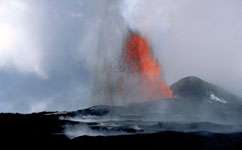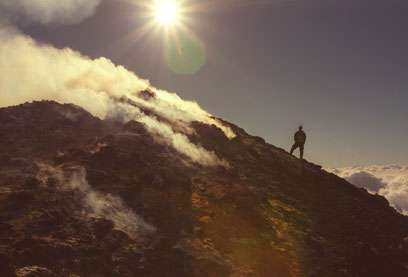Earthquakes are not enough warning for some volcanic eruptions

It may not always be possible to predict volcanic eruptions through rising numbers of earthquakes, say scientists.
Using earthquakes to warn of eruptions well before they occur is necessary in case safety measures and evacuations need be put into place.
Before many eruptions the rising pressure of magma causes the ground to deform and fracture - resulting in earthquakes. So, changes in the number or pattern of seismic activity around a volcano can often be a signal that it could be about to erupt.
But scientists have now shown this might not always be the case, and using earthquakes alone to signal eruptions may not give us enough warning.
Previous studies had suggested that, on average, earthquake activity at Kilauea, a Hawaiian volcano, increased for around two weeks leading up to an eruption. But new research has found this trend is not as clear- cut as scientists first thought and earthquakes may only provide a clear warning for one type of eruption.
Dr Andrew Bell, from the University of Edinburgh, and Dr Chris Kilburn, from University College London, used data collected by the Hawaiian Volcano Observatory since 1959 to test this accepted trend against what they were actually seeing at Kilauea.

The study, published in the Bulletin of Volcanology, shows that increases in earthquake activity can occur at different times in the lead up to different types of eruption. Earthquake activity can increase several weeks before an eruption, but only before eruptions caused by the magma chamber becoming over pressurised.
But eruptions caused by rocks slipping on the volcano's flanks are also common, and these show an increase in earthquake activity merely hours before they occur. 'We've shown that increased earthquake activity at Kilauea is not enough on its own to predict an eruption in the short-term,' explains Bell.
'Where the earthquakes give a long warning period, it's more applicable to a wider volcanic setting, particularly volcanoes that have not erupted for long periods of time' continues Bell. 'At Kilauea the more common type of eruption has an extremely short warning period. But for a small subset of its eruptions it shows increased activity for a while leading up to an event. We can use this to help forecast eruptions at volcanoes we have less information for.'
Since more earthquakes often occur during periods of volcanic unrest, understanding how and where they occur can be crucial to predicting an eruption before it occurs. Being able to quantify the earthquake trends at Kilauea may help scientists to forecast eruptions at volcanoes with a more limited record of behaviour, like Mount Etna in Sicily.
'Kilauea is an excellent place to study these pre-eruptive processes as there's a long history with multiple eruptions from 1959 to 1983. All of this data is recorded at the Hawaiian Volcano Observatory so it's a great resource,' Bell says.
Often the data set from other volcanoes is very small and there are very few well monitored eruptions. 'Using data from Kilauea as a way of seeing trends at these volcanoes is a bit of a trade-off. At Kilauea flank instability plays a bigger role than for other volcanoes, but we have a longer record to play with.'
Bell and Kilburn found that the previously reported trend was dependent on the quality of data – a key issue when dealing with any earthquake data catalogue that has been collected over a long period of time.
'Over time the sensitivity of equipment has improved and so in later years many more of the smaller earthquakes will be recorded compared to previous years. This means modelling trends is often extremely difficult as data quality changes,' explains Bell. 'Effectively in prior studies these data quality issues were not accounted for, and there was a degree of double counting data, so they saw an increase in seismic activity before eruptions even when there wasn't one.'
Although the direct implications for how volcanologists will be able to use this information to forecast other eruptions are still unclear, the team is now working on real time testing of forecast models during eruptions to see how well different factors predict these volcanic events.
More information: Bell, A. and Kilburn, C. (2013) Trends in the aggregated rate of pre-eruptive volcano-tectonic seismicity at Kilauea volcano, Hawaii. Bulletin of Volcanology, 75 (1) 1 - 10
Provided by PlanetEarth Online
This story is republished courtesy of Planet Earth online, a free, companion website to the award-winning magazine Planet Earth published and funded by the Natural Environment Research Council (NERC).



















